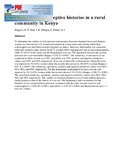Validity of contraceptive histories in a rural community in Kenya

View/
Date
1993Author
Maggwa, B N
Mati, J K
Mbugua, S
Hunter, D J
Type
ArticleLanguage
enMetadata
Show full item recordAbstract
To determine the validity of self-reported contraceptive histories obtained from rural Kenyan women, we interviewed 122 women participants in a long-term study during which their contraceptive use had been recorded regularly at clinics. Interview information was compared with each woman's clinic record. In all 71 women (58%) reported ever use of oral contraceptives, while 76 (62%) of the clinic records documented ever use. The agreement between the records and interview was reasonable (Kappa = 0.54, P < 0.001). The sensitivity of self-report of use compared to clinic records was 79%, specificity was 76%, positive and negative predictive values were 85% and 69% respectively. Ever use of injectable contraceptives (Depo-Provera) was reported by 78 (63%) women while the records showed use by 80 (65%) women (Kappa = 0.87, P < 0.001). The sensitivity, specificity, positive and negative predictive values were 94%, 93%, 96%, and 89% respectively. For the intrauterine contraceptive device, ever use was reported by 18 (14.8%) women while the records showed 19 (15.6%) (Kappa = 0.90, P < 0.001). The associated sensitivity, specificity, positive and negative predictive values were 90%, 99%, 94% and 98% respectively. The validity of reported duration of use of each method showed a similar pattern to that of the history of ever use. The Spearman's rank correlations for the duration of use calculated from interview compared with the clinic records were for oral contraceptives r = 0.68 (P < 0.001), injectables r = 0.81 (P < 0.001) and intrauterine devices r = 0.82 (P < 0.001).
URI
http://www.ncbi.nlm.nih.gov/pubmed/8225745http://erepository.uonbi.ac.ke:8080/xmlui/handle/123456789/29362
Citation
Int J Epidemiol. 1993 Aug;22(4):692-7.Publisher
Department of Obstetrics and Gynecology, University of Nairobi, Kenya.
Collections
- Faculty of Health Sciences (FHS) [10387]
